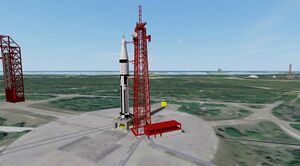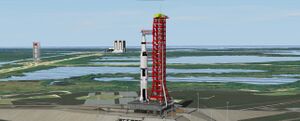First Steps
|
After you finished the Installation of the latest beta version the Project Apollo scenarios are in the "Project Apollo - NASSP" scenario folder and subfolders. Because of the ongoing development many of the scenarios and missions are not working yet, but you can try the missions and scenarios mentioned here.
Project Apollo - NASSP supports different levels of complexity or realism modes, so you can adjust the difficulty level you want to use. You choose the desired mode by choosing the appropriate scenario. At the moment there's the Quickstart mode for beginners, Standard mode and Virtual AGC mode are indended for the advanced user.
Quickstart mode

The Quickstart mode is intended for beginners, who are already familiar with Orbiter in general, but don't have much particular knowledge about Apollo and the historic spacecraft. If you aren't familiar with Orbiter yet, we suggest to try the built-in Deltaglider at first.
In Quickstart mode as much as possible is done automatically and the spacecraft behave as much as possible like standard Orbiter spacecrafts. It's only very rarely necessary to use the panel. All (or almost all) critical maneuvers are done by autopilot and you can also fly the spacecrafts "more manually" than the real Apollo spacecrafts.
Missions
The following missions and scenarios are available for Quickstart mode:
Standard mode

The Standard mode is intended for the advanced users, who already have some basic knowledge about the Apollo missions, are familiar with Orbiter and now want to do it like the real astronauts did.
In Standard mode everything is as authentic as possible and you have to fly the mission (almost) like the real thing. You have to do long checklists and control the internal systems manually. The spacecrafts behave more like the real ones, the SIVB is restartable only once for example.
A very important device of the Apollo spacecraft is the Apollo Guidance Computer (AGC), which normally does the guidance, navigation and control tasks. Unlike the Virtual AGC mode explained below the Standard mode uses the "NASSP AGC", which tries to behave similar to the real AGC but is an NASSP specific C++ program with several differences to the real AGC.
Missions
The following missions and scenarios are available for Standard mode:
Virtual AGC mode
The Virtual AGC mode is quite similar to the Standard mode, but another AGC implementation is used. The Virtual AGC, an Apollo Guidance Computer emulator running the original, authentic Apollo flight software (at the moment Colossus 1A, build 249 from October 28, 1968, flown with Apollo 9). It's still "experimental" and intended for the advanced user, who wants to have the ultimate realism, but of course with the Virtual AGC you can do all procedures exactly as described in the original documentation.
| ||
| Because of the AGC hardware emulation time acceleration higher then about 10x is not possible. |
Missions
The following missions and scenarios are available for Virtual AGC mode:
Unmanned missions
Also some of the unmanned Apollo missions are supported. The missions run automatically, you just need to activate time acceleration and wait for the next event, time acceleration will be deactivated a few minutes before that.